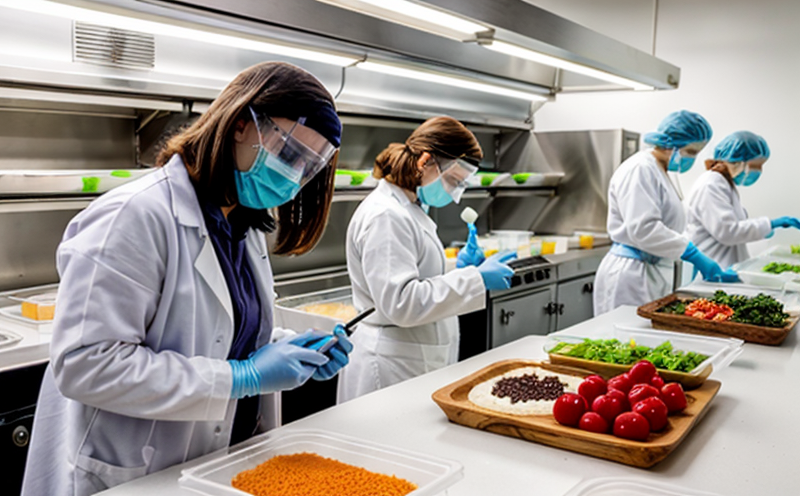ASTM E2617 Validation of Microbiological Test Methods in Food
The ASTM E2617 standard provides a framework for validating microbiological test methods used in food safety and quality control. This service is crucial for ensuring that the methods employed are accurate, reliable, and reproducible under real-world conditions. The validation process involves several critical steps: selecting appropriate media and reagents, establishing acceptable performance criteria, conducting performance evaluation experiments, and documenting all findings.
ASTM E2617 emphasizes the importance of using scientifically sound methodologies to assess method performance in terms of sensitivity, specificity, accuracy, precision, and robustness. Sensitivity is especially important for detecting low levels of pathogens that may be present in food products. Specificity ensures that only targeted organisms are identified, minimizing false positives which can lead to unnecessary recalls or rejections.
Accuracy refers to how closely the test results match known true values. Precision measures variability within replicate measurements under identical conditions, indicating whether the method provides consistent results across multiple runs. Robustness assesses a method’s ability to handle variations in sample matrix components and environmental factors without compromising performance.
The validation process typically begins by selecting representative strains of potential pathogens such as Salmonella spp., Listeria monocytogenes, or Escherichia coli O157:H7. These organisms are chosen based on their prevalence in the food industry and public health significance. Representative positive controls must be included during every run to ensure consistent performance.
Performance evaluation experiments involve inoculating test samples with known concentrations of target pathogens. The goal is to determine whether the method can detect these levels accurately while also evaluating its ability to differentiate between closely related species or strains. Negative control samples should also be tested to confirm that no false-positive results occur.
A key aspect of ASTM E2617 validation is ensuring compatibility with existing laboratory workflows and resources. This includes assessing whether the method requires specialized equipment, personnel training, or significant changes in operational procedures. Compliance officers and quality managers benefit greatly from this information when deciding which methods to adopt within their facilities.
R&D engineers find value in ASTM E2617 because it helps them design new tests that meet stringent regulatory requirements without compromising efficacy or efficiency. By adhering strictly to the guidelines laid out by ASTM E2617, they can ensure that their innovations will be accepted by regulatory bodies and ultimately improve food safety.
ASTM E2617 validation is particularly relevant for ensuring compliance with international standards such as ISO 11133:2017 which deals with the performance testing of microbiological methods used in the field of medical devices. While not directly applicable to food, understanding how these standards are applied can provide valuable insights into best practices.
Finally, thorough documentation is essential throughout the entire validation process. All relevant data points should be recorded meticulously and stored securely for future reference. Proper documentation ensures transparency during audits or inspections by regulatory agencies. It also serves as a valuable resource for training new personnel on proper technique and interpretation of results.
Why It Matters
The importance of ASTM E2617 validation cannot be overstated in today’s highly regulated global food industry. Accurate and reliable microbiological test methods are essential for maintaining high standards of product quality, protecting consumer health, and ensuring compliance with international regulatory frameworks.
- Consumer Trust: Reliable testing instills confidence among consumers regarding the safety and integrity of their purchases.
- Regulatory Compliance: Adhering to ASTM E2617 ensures that test methods meet stringent regulatory requirements, reducing the risk of non-compliance fines or sanctions.
- Risk Management: By validating test methods according to ASTM E2617 guidelines, companies can better manage risks associated with potential contamination events.
The stakes are particularly high in sectors where food safety is paramount such as pharmaceuticals and biotechnology. Missteps in microbiological testing could lead to severe consequences ranging from recalls to litigation. Therefore, investing time and resources into proper validation processes pays dividends in terms of long-term business stability and reputation.
Industry Applications
- Packaged Foods: Validation ensures that shelf-stable products meet shelf-life expectations despite prolonged storage conditions.
- Beverages: It guarantees the safety of fermented beverages like beer or wine, which depend heavily on microbial activity during production.
- Dairy Products: Ensures pasteurized milk and cheeses are free from harmful pathogens while retaining essential nutrients.
- Fresh Produce: Helps maintain quality standards for fruits and vegetables throughout harvesting, processing, and distribution stages.
- Poultry & Meat: Guarantees meat products remain safe for consumption even after extended refrigeration periods.
These applications illustrate the broad relevance of ASTM E2617 across various food categories. Each application has unique challenges that must be addressed during validation, making it a versatile standard applicable to diverse industries within the broader food sector.
Customer Impact and Satisfaction
- Better Product Quality: Validated test methods lead to consistent product quality across batches, enhancing customer satisfaction.
- Informed Decision-Making: Reliable data from validated tests allows companies to make informed decisions about ingredient sourcing or process changes.
- Reduced Waste: Accurate testing reduces the likelihood of rejecting good batches due to false positives, minimizing waste and costs.
- Enhanced Reputation: Consistently high-quality products improve brand reputation and market position among consumers.
The benefits extend beyond just internal operations; they directly impact end-users. Consumers appreciate knowing that the food items they purchase have been rigorously tested for safety and quality. This perception translates into higher loyalty rates and repeat business opportunities for suppliers who prioritize ASTM E2617 compliance.





